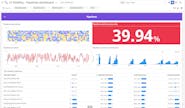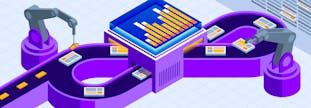What is Shift-Left Testing?
Within the software lifecycle, testing new code or application processes typically comes at the end of development. Post-development testing can bring about a rush to the finish line as developers must quickly resolve bugs or fix newly discovered issues. This rush, in turn, can lead to quality issues, as well as increases to project timelines and costs. In this setting, development and testing are treated not only as separate efforts but sometimes as separate parts of the same project team—with little communication between the two except for notes exchanged through bug trackers and similar apps during the testing phase.
Shift-left testing is a solution where testing is performed continuously throughout the development phase rather than at the end. The term “Shift left” comes from moving the test phase “left” on the timeline into the development phase. By moving tests earlier into the development phase, shift-left testing can improve CI/CD workflows. It:
- Continuously integrates tests within pipelines
- Identifies issues and errors sooner
- Improves quality and reduces time to release
How Does Shift-Left Testing Work?
Prior to shift-left testing, end-to-end, unit, validation, and other forms of testing often came during the traditional quality assurance (QA) portion of software development. A separate testing cycle meant testers were working apart from developers. Working on their own path to complete requirements, developers would sometimes use mock data or perform their own “easy path” unit tests to ensure code or scripts worked until they reached the testers.
By moving testing into the development phase (shifting left on the development path), developers and testers can work together to check for security issues and vulnerability problems. They can also perform end-to-end, validation, and synthetic tests earlier rather than waiting for problems to appear right before shipping code to production.
What Are the Benefits of Shift-Left Testing?
Shift-left testing does more than move the testing phase into the development workflow. Not only does shifted testing validate development processes, but it can also provide insights into security and connectivity issues. For example, a CI pipeline can touch upon outside data sources through third-party APIs. An error returned from one of these outside APIs could mean changes occurred in the API’s specs that were not thoroughly documented nor expected in the original code development plan. Unit, integration, and end-to-end testing coupled with development can reveal these issues much earlier—and resolve them—rather than later during traditional QA testing.
Shift left testing improves development practices by:
- Optimizing the development/testing infrastructure
- Identifying integration, security, and validation issues
- Monitoring the performance of CI/CD pipelines
Not only are issues and errors resolved earlier and faster, but developers and testers are able to collaborate on building releases using a clear, combined build-test strategy. One of the byproducts of this approach is an acceleration in productivity: teams can deliver at a much faster rate and with fewer errors. By combining development with testing, shift-left testing can ensure a more robust CI/CD process.
How Can Shift-Left Testing and Shift-Left Observability Reduce Mean Time to Resolution?
Complex integrations, when built in the traditional pattern of software development, can lead to unwanted surprises when it’s time for testing. Waiting for development to complete code units before testing can create a logjam of QA tests, leading to multiple, difficult-to-trace points of failure and unwanted project timeline creep.
Working with shift-left testing, shift-left observability integrates observability practices and tools into CI/CD pipelines, which provides real-time visibility into the performance and behavior of the application or system being tested. Shift-left observability allows developers to connect to their live applications from their existing tools.
Shift-left testing and shift-left observability save time and resources by allowing development/testing teams to address potential logjams before they send a cascade of failures through CI/CD pipelines.
What are the Challenges of Shift-Left Testing?
For all its advantages, shift-left testing can be difficult for teams to adopt for several reasons. It emphasizes changes in project team composition by consolidating testers with developers. This can be a marked change in work styles since developers may be accustomed to working on requirements or issues with their own copies of code and data structures to facilitate building and locally testing their code. On the other side of the aisle, testers may have their own QA environments that do not necessarily reflect development versions. When these two separate units come together as part of a single, cohesive team, developers and testers must agree upon a working version or snapshot of the code environment, use established data structures, and commit their work and testing to a final code base.
In the past, software development cycles required testers to conduct manual testing, and the process did not lend itself to continuous testing. Improvements in test automation—especially in CI/CD dashboards—now make it easier to introduce and run automated tests. With automated testing, testers can focus on finding outliers and discovering bugs while developers are immediately notified when tests fail due to code changes.
Here are some suggested steps that can improve the chances for success with teams trying to adopt shift-left testing:
- Use dashboards and other tools to provide real-time information on KPIs for new features as they are added to the development cycle.
- Plan for development and QA to work together to introduce tests sooner and test builds more often.
- Work with DevOps to conduct backend tracing, logging, and metrics to track and resolve errors and reduce time to delivery of new features.
- Track service-level objectives, bugs, and errors to ensure high-quality releases.
What are the Best Tools for Shift-Left Testing?
Datadog Software Delivery helps Platform Engineering & DevOps teams support shift-left testing and shift-left observability as it monitors your CI/CD environment. By integrating with Datadog Synthetic Monitoring, many common testing frameworks, and popular CI providers, your teams can review pipelines and tests at all phases of the CI/CD lifecycle.
Datadog Software Delivery provides out-of-the-box dashboards and monitoring for pipelines, stages, and jobs to identify performance and health issues across your CI/CD ecosystem. Your team can review pipeline execution visualizations, messages, and errors as well as contextual logs, infrastructure metrics, and full traces of your software tests. In addition, Datadog also provides ways to triage flaky tests that may slowing your development team down.
To learn more about shift-left testing and Datadog, see Datadog Software Delivery and our documentation.



